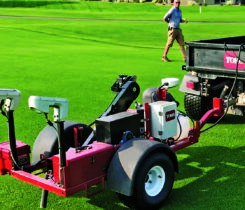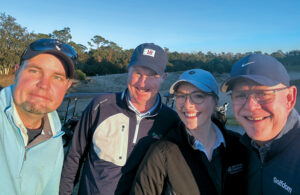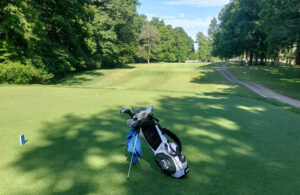Examining spring dead spot response to different management practices
Hybrid bermudagrasses are highly susceptible to the destructive fungal disease spring dead spot (SDS) in areas where cold or freezing temperatures occur. Three species of Ophiosphaerella are known to cause SDS in the U.S.: O. korrae, O. herpotricha, and O. narmari. Past research by pathologists finds O. korrae and O. herpotricha are commonly isolated from infected patches.

Response of spring dead spot caused by Ophiosphaerella korrae (left side of each plot) and O. herpotricha (right side of each plot) to nitrogen (N) sources as observed on May 1, 2009. Plots received (A) ammonium sulfate and (B) calcium nitrate as the sole N source in 2006, 2007 and 2008. (Photo: Lane Tredway)
Researchers at North Carolina State University, in cooperation with Syngenta Crop Protection, evaluated the effects of nitrogen (N) source, fall fertilization and preventive fungicides on common bermudagrass artificially inoculated with O. korrae and O. herpotricha.
Spring dead spot pathogens respond differently to management practices. For example, they evaluated preventive fungicides to control SDS effectively. Preventive applications of propiconazole, both propiconazole and azoxystrobin, tebuconazole or fenarimol provided effective control of O. herpotricha but failed to provide significant suppression of O. korrae.
The researchers also evaluated N sources (ammonium sulfate or calcium nitrate) to suppress the SDS pathogens. The source of N applied to bermudagrass from May to Aug. 2006-2008 significantly affected SDS symptoms in the spring of 2007-2009.
Ammonium sulfate [(NH4)₂SO₄] provided excellent suppression of O. herpotricha but did not affect O. korrae. However, O. korrae was suppressed instead by calcium nitrate (CaNO3). Fall applications of K, S, gypsum or dolomitic lime did not influence SDS development.
The differential response of SDS pathogens to fertilization practices and preventive fungicide applications highlights the importance of pathogen identification in developing integrated management programs.
More research is needed to determine the underlying mechanisms responsible for the suppression of SDS with N sources and the potential role of manganese and calcium in disease development.












